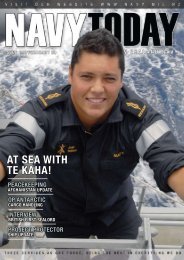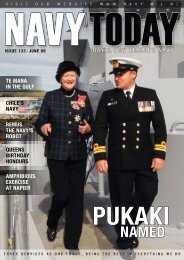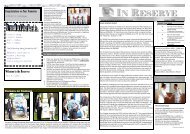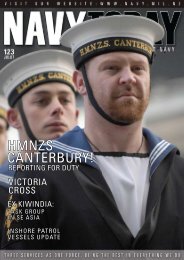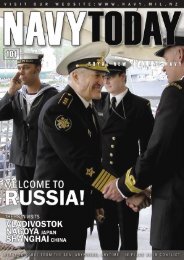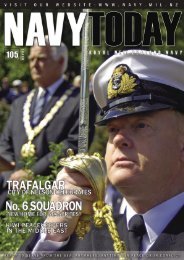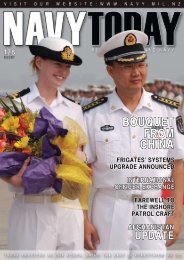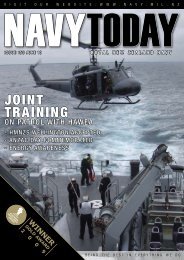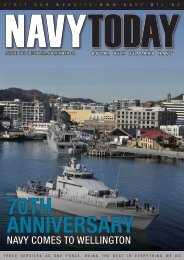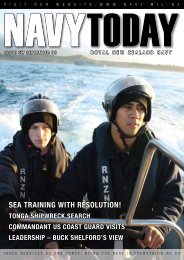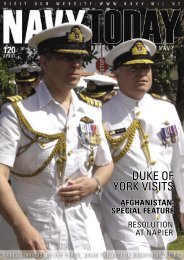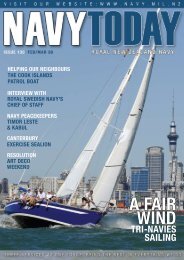May 2012, Issue 166 - Royal New Zealand Navy
May 2012, Issue 166 - Royal New Zealand Navy
May 2012, Issue 166 - Royal New Zealand Navy
Create successful ePaper yourself
Turn your PDF publications into a flip-book with our unique Google optimized e-Paper software.
information on local fishing and trading vessel<br />
activity, and responding to intelligence cueing<br />
of suspected maritime terrorist related activity<br />
such as narcotics smuggling. The number of<br />
ships assigned to CTF 150 varies according<br />
to the ebb and flow of national contributions<br />
with ship patrol cycles being determined by<br />
national port visit programs. At all times our<br />
units are ready to respond to any piracy event<br />
(in support of CTF 151 – the counter piracy<br />
mission) or to render humanitarian aid and<br />
assistance to vessels in distress.<br />
“One of our most notable successes<br />
has been the interdiction of a dhow in the<br />
North Arabian Sea carrying 240kgs of illegal<br />
narcotics with an estimated street value of<br />
US$5 million,” said CAPT Cook. “The RAN<br />
ANZAC class frigate HMAS PARRAMATTA<br />
conducted the interception, boarding and<br />
search of the vessel which resulted in the<br />
discovery of the narcotics in bags of flour.<br />
The illicit cargo was disposed of at the scene.<br />
The result was the first successful narcotics<br />
interdiction by a CMF ship in two and half<br />
years and was due to the cooperation and<br />
planning efforts of many stakeholders.”<br />
Another highlight was Focused Operation<br />
SCIMITAR ANZAC in the Southern Red Sea/<br />
Gulf of Aden region involving a task group of<br />
four ships under the tactical control of CAPT<br />
Cook and his afloat command element. The<br />
purpose of this four-day maritime security<br />
operation was to ensure the safe unimpeded<br />
passage of merchant shipping through this key<br />
strategic waterway and to collect pattern of life<br />
information on local maritime activity. The task<br />
counter-terror op<br />
group consisted of HMS DARING (the new RN<br />
first of class Type 45 Destroyer), Pakistan Naval<br />
Ship BABUR (ex RN Type 21 frigate), HMAS<br />
PARRAMATTA and <strong>Royal</strong> Fleet Auxiliary WAVE<br />
KNIGHT, and was supported by USN P3 aircraft<br />
providing area surveillance.<br />
This activity was notable for the embarkation<br />
of the command element on HMS DARING<br />
which is on its maiden seven-month<br />
deployment. This was the first such occasion<br />
that the ship has acted as a command<br />
platform. With regional engagement being<br />
a strong line of operation for CMF and CTF<br />
150, personnel from the Yemeni <strong>Navy</strong> and<br />
Coast Guard were embarked in HMS DARING<br />
and HMAS PARRAMATTA to provide their<br />
local knowledge of the physical environment<br />
and maritime activity. This is Yemen’s front<br />
yard and their knowledge of the pattern of<br />
life is essential for CTF 150 establishing the<br />
indicators of potential terrorist maritime activity<br />
in this key part of the area of operations.<br />
SCIMITAR ANZAC also provided the<br />
opportunity to travel to Djibouti, a former<br />
French territory which gained independence in<br />
1977. It is a tiny country, strategically situated<br />
between the entrance to the Red Sea and the<br />
western edge of the Gulf of Aden. Djibouti has<br />
a significant regional port of the same name<br />
which is the gateway to North Africa as the<br />
country borders Eritrea, Ethiopia and Somalia.<br />
The port also provides a key logistics hub for<br />
the various naval forces operating in the Gulf<br />
of Aden and Somali Basin on counter piracy<br />
operations namely CTF 151, EUNAVFOR, NATO<br />
and the independent nations such as Russia,<br />
Japan and China which undertake convoy<br />
escort of their national shipping. Djibouti<br />
is also the location of Camp Lemonnier; the<br />
supporting base for Combined Joint Task<br />
Force – Horn of Africa from which US and<br />
coalition forces conduct stability operations<br />
in NE Africa.<br />
At the time of writing this article, the<br />
contingent has passed the two thirds mark<br />
of the deployment. “We remain focused on<br />
employing the ships and aircraft under our<br />
command to best meet the counter terrorism<br />
aims of the CTF 150 mission,” said CAPT<br />
Cook. “We are hopeful that our concerted<br />
efforts will result in another successful<br />
narcotics interdiction before we hand over<br />
command to Pakistan on 19 April <strong>2012</strong>.”<br />
Both RNZN officers are thoroughly enjoying<br />
the camaraderie of our RAN cousins and the<br />
strong professional relationship that binds this<br />
contingent together.<br />
<strong>New</strong>s updates on the activities of the<br />
RAN led CTF 150 can be found by googling<br />
Combined Maritime Forces.<br />
WWW.NAVY.MIL.NZ NT<strong>166</strong>april-may12 23



